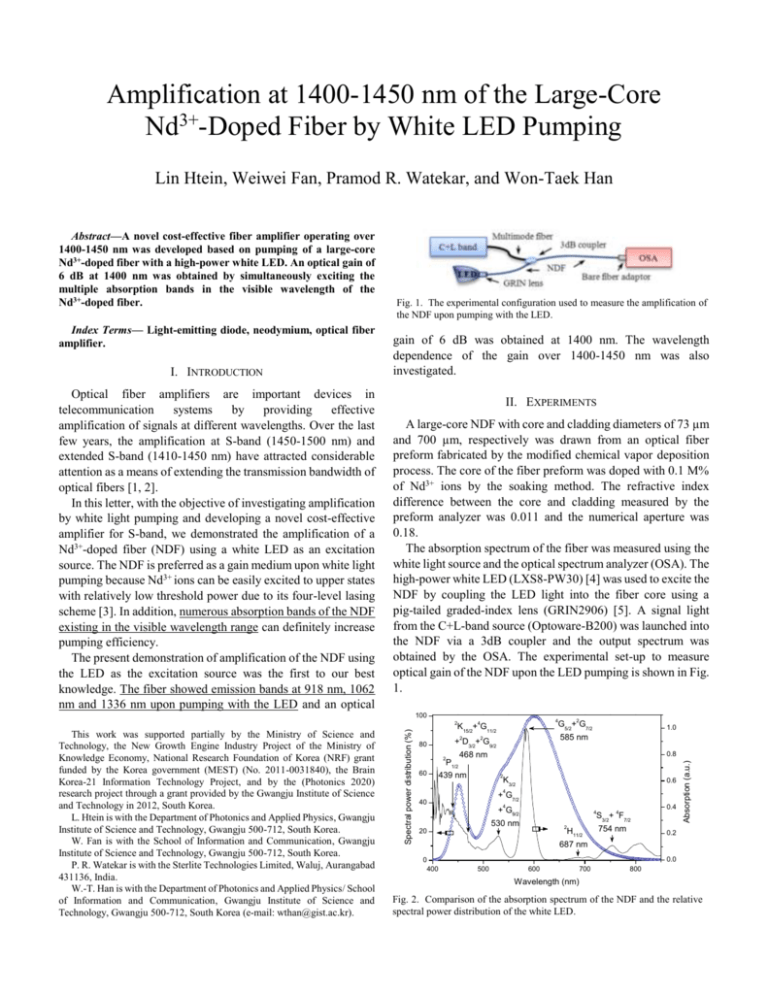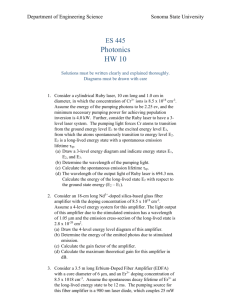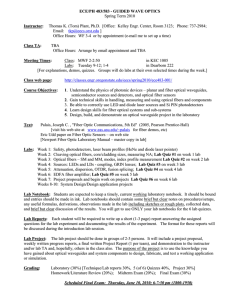II. Experiments
advertisement

Amplification at 1400-1450 nm of the Large-Core Nd3+-Doped Fiber by White LED Pumping Lin Htein, Weiwei Fan, Pramod R. Watekar, and Won-Taek Han Index Terms— Light-emitting diode, neodymium, optical fiber amplifier. I. INTRODUCTION Optical fiber amplifiers are important devices in telecommunication systems by providing effective amplification of signals at different wavelengths. Over the last few years, the amplification at S-band (1450-1500 nm) and extended S-band (1410-1450 nm) have attracted considerable attention as a means of extending the transmission bandwidth of optical fibers [1, 2]. In this letter, with the objective of investigating amplification by white light pumping and developing a novel cost-effective amplifier for S-band, we demonstrated the amplification of a Nd3+-doped fiber (NDF) using a white LED as an excitation source. The NDF is preferred as a gain medium upon white light pumping because Nd3+ ions can be easily excited to upper states with relatively low threshold power due to its four-level lasing scheme [3]. In addition, numerous absorption bands of the NDF existing in the visible wavelength range can definitely increase pumping efficiency. The present demonstration of amplification of the NDF using the LED as the excitation source was the first to our best knowledge. The fiber showed emission bands at 918 nm, 1062 nm and 1336 nm upon pumping with the LED and an optical Fig. 1. The experimental configuration used to measure the amplification of the NDF upon pumping with the LED. gain of 6 dB was obtained at 1400 nm. The wavelength dependence of the gain over 1400-1450 nm was also investigated. II. EXPERIMENTS A large-core NDF with core and cladding diameters of 73 µm and 700 µm, respectively was drawn from an optical fiber preform fabricated by the modified chemical vapor deposition process. The core of the fiber preform was doped with 0.1 M% of Nd3+ ions by the soaking method. The refractive index difference between the core and cladding measured by the preform analyzer was 0.011 and the numerical aperture was 0.18. The absorption spectrum of the fiber was measured using the white light source and the optical spectrum analyzer (OSA). The high-power white LED (LXS8-PW30) [4] was used to excite the NDF by coupling the LED light into the fiber core using a pig-tailed graded-index lens (GRIN2906) [5]. A signal light from the C+L-band source (Optoware-B200) was launched into the NDF via a 3dB coupler and the output spectrum was obtained by the OSA. The experimental set-up to measure optical gain of the NDF upon the LED pumping is shown in Fig. 1. 100 Spectral power distribution (%) 2 This work was supported partially by the Ministry of Science and Technology, the New Growth Engine Industry Project of the Ministry of Knowledge Economy, National Research Foundation of Korea (NRF) grant funded by the Korea government (MEST) (No. 2011-0031840), the Brain Korea-21 Information Technology Project, and by the (Photonics 2020) research project through a grant provided by the Gwangju Institute of Science and Technology in 2012, South Korea. L. Htein is with the Department of Photonics and Applied Physics, Gwangju Institute of Science and Technology, Gwangju 500-712, South Korea. W. Fan is with the School of Information and Communication, Gwangju Institute of Science and Technology, Gwangju 500-712, South Korea. P. R. Watekar is with the Sterlite Technologies Limited, Waluj, Aurangabad 431136, India. W.-T. Han is with the Department of Photonics and Applied Physics/ School of Information and Communication, Gwangju Institute of Science and Technology, Gwangju 500-712, South Korea (e-mail: wthan@gist.ac.kr). 4 2 2 P1/2 60 1.0 585 nm 2 + D3/2+ G9/2 80 2 G5/2+ G7/2 4 K15/2+ G11/2 0.8 468 nm 439 nm 2 K3/2 0.6 4 + G7/2 40 0.4 4 + G9/2 4 4 S3/2+ F7/2 530 nm 2 H11/2 20 754 nm Absorption (a.u.) Abstract—A novel cost-effective fiber amplifier operating over 1400-1450 nm was developed based on pumping of a large-core Nd3+-doped fiber with a high-power white LED. An optical gain of 6 dB at 1400 nm was obtained by simultaneously exciting the multiple absorption bands in the visible wavelength of the Nd3+-doped fiber. 0.2 687 nm 0 400 0.0 500 600 700 800 Wavelength (nm) Fig. 2. Comparison of the absorption spectrum of the NDF and the relative spectral power distribution of the white LED. Figure 2 compares the absorption bands of the NDF in visible wavelength with the emission spectrum of the white LED [4]. The absorption bands of the NDF at 439 nm, 468 nm, 530 nm, 585 nm, 687 nm and 754 nm corresponding to the transitions from the ground state of 4I9/2 to the upper excited states of 2P1/2, 2 K15/2+4G11/2+2D3/2+2G9/2, 2K3/2+4G7/2+4G9/2, 4G5/2+2G7/2, 2H11/2 and 4S3/2+4F7/2, respectively were well-located within the emission spectrum of the LED and thus it offers the multiple wavelength pumping schemes [6, 7]. The emission bands of the NDF were found to appear peaking at 918 nm, 1062 nm and 1336 nm upon the LED pumping in Fig. 3. Among them, the most interesting peaks were those centered at 1062 nm and 1336 nm with the effective bandwidths of 51 nm and 72 nm, respectively, which were about 17 nm and 32 nm broader than those reported by others [8, 9]. For a better understanding of the energy levels involved, a schematic energy level diagram of Nd3+ by the LED pumping with the absorption and emission transitions is shown in Fig. 4. The white light from the white LED excited the electrons from the ground state of 4I9/2 to the upper excited states of 2P1/2, 2 K15/2+4G11/2+2D3/2+2G9/2, 2K3/2+4G7/2+4G9/2, 4G5/2+2G7/2, 2H11/2 and 4S3/2+4F7/2. Then the electrons in the upper levels decayed Optical power (dBm) -40 -45 -50 -55 -60 -65 -70 900 1000 1100 1200 1300 1400 1500 Wavelength (nm) Fig. 3. Emission spectrum over the wavelength range of 860-1510 nm upon pumping the NDF of 2 m in length with the LED. 2 2 21 P1/2 K15/2+4G11/2+2D3/2+2G9/2 K3/2+4G7/2+4G9/2 G5/2+2G7/2 2 H11/2 4 S3/2+4F7/2 -61 2 12 1336 nm 918 nm 1062 nm 4 687 nm 754 nm 6 Gain 3 0 Pump Nd3+ Emission F3/2 4 I15/2 4 I13/2 4 I11/2 4 I9/2 Fig. 4. Schematic energy levels of Nd3+ by the LED pumping. The up arrows at left and the down arrows at right indicate the pumping and emission bands, respectively. 5 -63 Power (dBm) 15 9 -62 4 439 nm 468 nm 530 nm 585 nm Energy (103 cm-1) 18 6 Ps out ASE -64 4 -65 -66 -67 1400 3 Ps in 1410 Gain (dB) III. RESULTS AND DISCUSSION non-radioactively to the 4F3/2 metastable state, from which they relaxed to the 4I9/2, 4I11/2 and 4I13/2 states and thus the emission bands appeared peaking at 918 nm, 1062 nm and 1336 nm, respectively. Although the NDF exhibited three emission bands at 918 nm, 1062 nm and 1336 nm, the band at 1336 nm is of interest due to its application to amplifiers used for telecommunication purpose. In general, fluoride fibers are more favorable for the amplification of signal around 1310-1360 nm [10, 11]. In the case of the present silicate fibers, however, the gain around the peak of the emission band was eliminated due to the strong excited state absorption (ESA) from the 4F3/2 → 4G7/2 transition which absorbed the ~1160-1380 nm signal and thus brought about a significant loss [2, 12]. Thus, the gain was possible only at the wavelength longer than 1380 nm on the edge of the ESA band. The amplification characteristics over 1400-1450 nm arisen from 4F3/2 → 4I13/2 transition were investigated at the fiber length of 2 m upon pumping with the LED. Figure 5 shows the wavelength dependence of input signal (Ps in), amplified output (Ps out), amplified spontaneous emission (ASE) and optical gain as well. The maximum gain of 5.8 dB was obtained at 1400 nm. Since the significant amounts of ESA exist at longer wavelength [13] where the optical gain decreased more rapidly than the ASE, the gain dropped to nearly 2.5 dB at 1450 nm. Table I compares the gain of LED-pumped NDFA with that of others: (1) Nd-doped fluoride fiber amplifier pumped at 795 nm by a Ti-sapphire laser [10], (2) Nd-doped fluorozirconate fiber amplifier pumped at 496 nm by an Ar laser [11] and (3) Nd-doped silica fiber amplifier pumped at 800 nm [2]. Although the two NDFAs (1) and (2) based on fluoride glass fibers showed the optical gains of 5 dB at 1340 nm and 10 dB at 1330 nm upon pumping at 795 nm and 496 nm, respectively, the gain coefficients (Gain/Ppump = 0.03-0.07 dB/mW) were rather low. On the other hand, the NDFA (3) based on silica glass fiber was found to have the gain of 22 dB at 1400 nm. Despite the 22 dB gain was reported in the NDFA (3), its gain coefficient (0.11 dB/mW) was much less than that of the present work, 6 dB gain at 1400 nm with the gain coefficient of 2.31 dB/mW upon 1420 1430 1440 1450 Wavelength (nm) Fig. 5. (Lines, left axis) The wavelength dependence of input signal (P s in), amplified output (Ps out) and amplified spontaneous emission (ASE). (Squares, right axis) Optical gain as a function of wavelength. TABLE I. COMPARISON OF THE OPTICAL GAIN OF THE LED-PUMPED NDFA AND OTHER AMPLIFIERS s (nm) 1340 1330 1400 1400 p (nm) 795 496 800 420-750 Ppump (mW) 190 150 200 2.6 Gain (dB) 5 10 22 6 pumping provides a cost-effective fiber amplifier for S-band. REFERENCES Gain/Ppump Ref. (dB/mW) 0.03 [10] 0.07 [11] 0.11 [2] 2.31 This work pumping at low power. For the amplification arisen from the 4F3/2 → 4I13/2 transition, the gain of the NDFA is limited not only by the presence of strong ESA around 1336 nm but also by the existence of ASE from the competitive transitions of much stronger emission bands at 918 nm and 1062 nm. Nonetheless, the ASE can be discriminated by designing the index profile, in particular, removing the active ions from the center of the fiber [14]. Thereby, the gain improvement of up to 18 dB was achieved in the Nd/Yb doped fiber having index profile with a multiple layer cladding [2]. Therefore, further improvement in the performance of the LED-pumped NDFA can be possible by optimizing the NDF structure. IV. CONCLUSION A 1400-1450 nm band optical amplifier with an optical gain of 6 dB at 1400 nm was demonstrated by simultaneously exciting the absorption bands of the large-core NDF located at 439 nm, 468 nm, 530 nm, 585 nm, 687 nm and 754 nm with white LED. The emission bands at 918 nm, 1062 nm and 1336 nm were found upon pumping the NDF with the LED. The emission band at 1336 nm from the transition of 4F3/2 → 4I13/2 was shown with wide effective bandwidth of 72 nm and thus very short pulse amplification can be possible. The present demonstration of amplification of the NDF by the LED [1] T. Kasamatsu, Y. Yano, and T. Ono, “1.49-µm-band gain-shifted thulium-doped fiber amplifier for WDM transmission systems,” J. Lightwave Technol., vol. 20, no. 10, pp. 1826–1838, Oct. 2002. [2] D. J. DiGiovanni and K. Rottwitt, “Optical fiber communication system employing Nd doped fiber amplifier for the 1400 nm window,” US Patent 6363194 B1, Mar. 2002. [3] C. J. Koester and E. Snitzer, “Amplification in a fiber laser,” Appl. Opt., vol. 3, no. 10, pp. 1182–1186, Oct. 1964. [4] Available: http://www.philipslumileds.com. [5] Available: http://www.thorlabs.hk. [6] M. J. F. Digonnet (Ed.), Rare-earth-doped fiber lasers and amplifiers (Marcel Dekker, Inc., 1993). [7] L. Htein, W. Fan, P. R. Watekar, and W.-T. Han, “Amplification by white light-emitting diode pumping of large-core Er-doped fiber with 12 dB gain,” Opt. Lett., vol. 37, no. 23, pp. 4853–4855, Dec. 2012. [8] I. M. Thomas, S. A. Payne, and G. D. Wilke, “Optical properties and laser demonstrations of Nd doped sol-gel silica glasses,” J. Non-Cryst. Solids, vol. 151, no. 3, pp. 183–194, Dec.1992. [9] J. H. Choi, F. G. Shi, A. Margaryan, A. Margaryan, and W. E. van der Veer, “Optical absorption and emission properties of Nd 3+-doped fluorophosphates glass for broadband fiber amplifier applications,” Proc. SPIE 4974, Advances in Fiber Lasers, p. 106, July 2003. [10] M. Brierley, S. Carter, P. France, and J. E. Pedersen, “Amplification in the 1300 nm telecommunications window in a Nd-doped fiber,” Electron. Lett., vol. 26, no. 5, pp. 329–330, Mar. 1990. [11] Y. Miyajima, T. Komukai, T. Sugawa, “1.31-1.36 µm optical amplification in Nd3+-doped fluorozirconate fibre,” Electron. Lett., vol. 26, no. 3, pp. 194–195, Feb. 1990. [12] P. R. Morkel, M. C. Farries, and S. B. Poole, “Spectral variation of excited state absorption in neodymium doped fibre lasers,” Opt. Commun., vol. 67, no. 5, pp. 349–352, Aug. 1988. [13] D. W. Hewak, “Progress towards a 1300 nm fibre amplifier,” IEE Colloquium on New Developments in Optical Amplifiers, no. 492, pp.12/1–12/5, Nov. 1998. [14] A. Bjarklev, T. Rasmussen, J. H. Povlsen, O. Lumholt, K. Rottwitt, S. Dahl-Petersen, and C. C. Larsen, “9 dB gain improvement of 1300 nm optical amplifier by amplified spontaneous emission suppressing fibre design,” Electron. Lett., vol. 27, no. 19, pp. 1701–1702, Sept. 1991.








